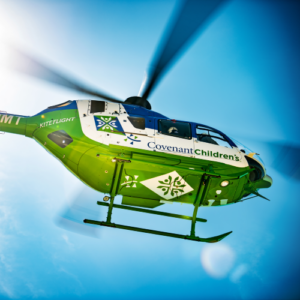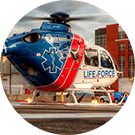In trauma, when getting a patient to definitive care – whether that care be a hospital, trauma center or surgical suite, time is of the essence. The Golden Hour, defined as the first hour after the occurrence of a traumatic injury or event, during which treatment is likely to be the most effective, has long been believed to be the standard timeframe in which trauma victims should arrive at a facility for lifesaving treatment.
You may be familiar with EMS deserts , parts of the country where access to higher levels of care require more precious time than it would in other parts of the country, sometimes more than the revered Golden Hour. Patients in these rural EMS deserts often face intense disadvantages when they become seriously ill or injured for many reasons, with a lack of appropriate, timely emergent care topping the list. Unfortunately, for many traumatic injuries, the Golden Hour is a challenge**. Patients don’t have sixty minutes to arrive at an ER or trauma center – they need lifesaving intervention now.
Rural Air Ambulances and The Golden Hour
Imagine you are one of the 30 million Americans who live in a rural area, more than an hour away from a trauma center and who could experience a 50% higher mortality rate from traumatic injury than your urban counterparts (1). Maybe you are one of the 100,000 patients transported by an AirMedCare Network (AMCN) provider’s air ambulance every year, who experiences an accident that requires a trauma center for a surgery to reattach a limb, stop hemorrhage, stabilize a spinal column, repair a lacerated organ or any of the myriad reasons air ambulances are called to a scene for patients. You may be waiting on scene with medical personnel who are not able to give you the treatment you need to extend that Golden Hour – like blood transfusions or intubation. But when an air ambulance arrives, the ER is practically brought to you. Not only is the time you receive that definitive care dramatically reduced with air ambulances, on-scene and in-air treatments that maintain the patient during transport are another critical element of helicopter EMS care. Having the appropriate medical provider for your emergency transportation is crucial to improved outcomes. Air ambulance crews are some of the highest-level pre-hospital providers in EMS and can perform interventions that ground crews cannot for a variety of reasons – from licensing restrictions to availability of interventions, like blood transfusions within their scope of practice.
Air Ambulance Membership for Rural Communities
Bridging the gap in emergency transport for rural communities is vital to ensuring better outcomes for patients suffering a traumatic injury or event. When the Golden Hour is too long, having the highest pre-hospital treatments brought to the scene helps to stabilize critical patients, so they can arrive at the right facility to treat their injuries. While the Golden Hour is a challenge for many patients, it nevertheless indicates the importance of time and rapid response to traumatic injuries and events. Air ambulances are uniquely equipped to capitalize on treatment availability and speed, ensuring the best possible outcome for patients.
Even with insurance, the cost of an emergency air ambulance can be expensive. For those who don’t want the added stresses of unplanned medical bills, AirMedCare Network providers offer world-class pre-hospital air ambulance treatment and transport that costs zero out-of-pocket for their members. Membership starts at $99, or $79 per year for seniors, and covers the entire household. For those rural communities who are in greatest need because of time to definitive treatment, Air Ambulance membership can help protect your finances while expert helicopter EMS crews get patients the needed care at moment’s notice. See if an AirMedCare Network provider is located in your community at https://www.airmedcarenetwork.com/air_ambulance-service/coverage-area-pricing
Learn more about how our skilled Helicopter EMS teams ensured a 1 y/o child hit by a lawnmower was assisted by Air Evac Lifeteam crews, helping him make a full recovery.
(1) Carr, B. G., Bowman, A. J., Wolff, C. S., Mullen, M. T., Holena, D. N., Branas, C. C., & Wiebe, D. J. (2017). Disparities in access to trauma care in the United States: A population-based analysis. Injury, 48(2), 332–338. https://doi.org/10.1016/j.injury.2017.01.008
Trauma Mortality and the Golden Hour • LITFL • CCC Trauma
Frequently Asked Questions:
If an AirMedCare Network Provider does not transport you, you will be responsible for payment. Our membership program only covers transports provided by our affiliates.
There is no limit to the number of transports a member may take in a year. Each transport is handled the same way and must be an emergent or time-sensitive transport as determined by a physician (or other appropriate provider) or first responder unaffiliated with AMCN.
With an AirMedCare Network membership, any person or persons who reside under one (residential) roof are covered. In the event we have a member who lives in a duplex or apartment complex, we designate the primary member’s residence/address— that is considered the “one roof”. Undergraduate college students can be covered under their parent’s membership as well as anyone previously residing in the household who is then moved to a permanent care facility.

Tips for Flying while Pregnant
Most pregnancies are uneventful, and women can continue with their daily lives with few restrictions. Flying, however, might not be an activity that is right

Prepare for Travel with Expert Pre-travel Health Tips
Pre-travel health care is important for both domestic and international trips. It helps ensure you are ready to handle any common health problems that might

Neonatal Intensive Care – Be prepared for baby with this important information.
Having a child can be both exciting and a little scary. New parents want to be ready for their baby’s arrival and make sure they




